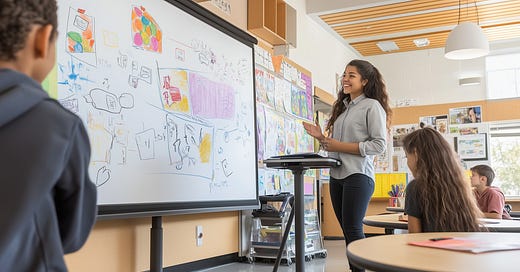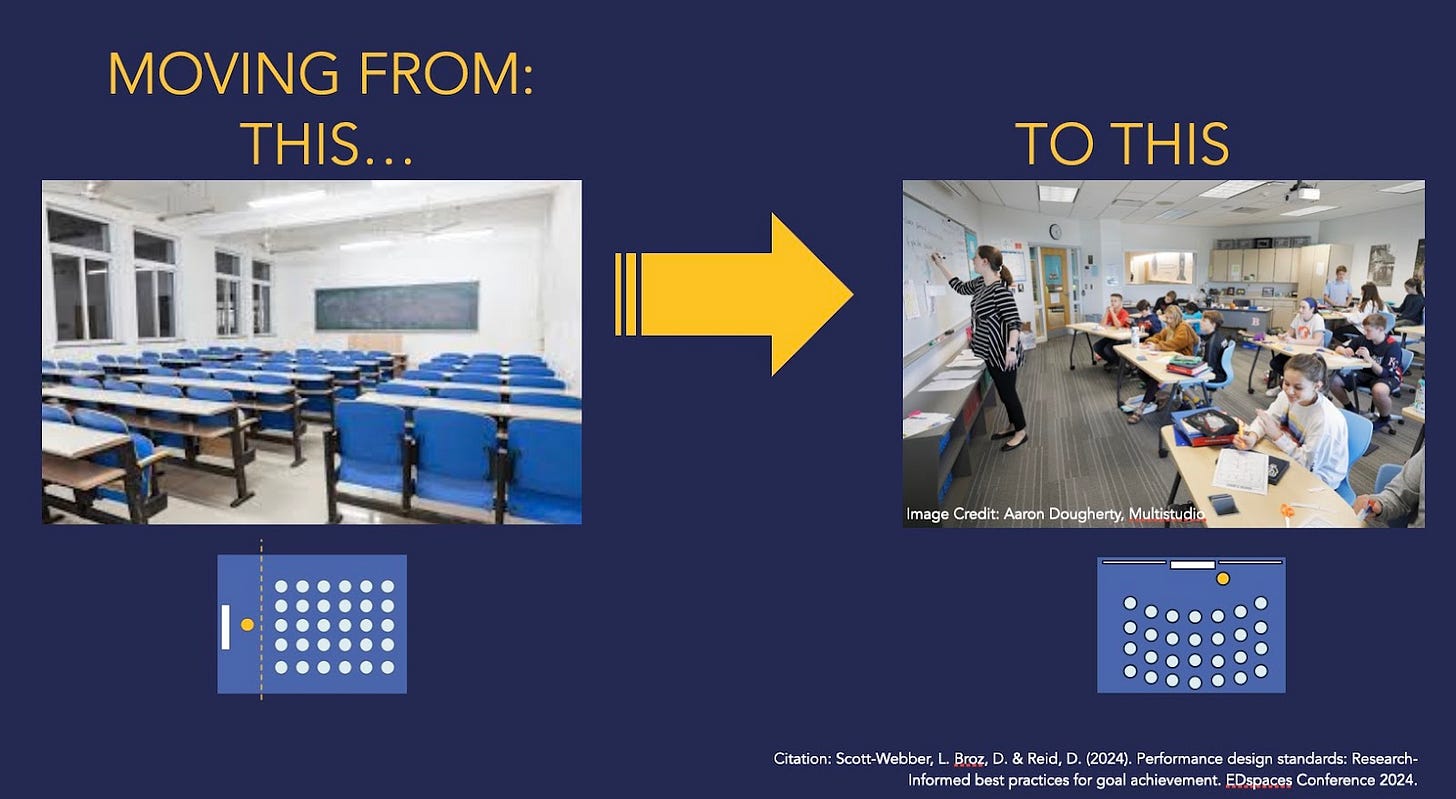Special thanks to our dear friend Lennie Scott-Webber for her research contributions and editorial expertise that strengthened this piece.
The most powerful classroom interventions often happen at the edges—where space meets learning, where environment shapes cognition. Yet, when seeking to improve test scores, many educators look first to curriculum overhauls, expensive technology, or intensive remediation programs.
What if I told you that some of the most impactful changes cost less than a tank of gas?
Research increasingly confirms what intuitive teachers have always sensed: our physical environments profoundly shape our mental states. The space around us isn't neutral—it actively enables or constrains thinking, focus, and learning. For students, whose developing brains are especially responsive to environmental cues, thoughtful classroom design isn't a luxury—it's foundational to academic success.
Let's explore six evidence-backed environmental shifts that can transform learning outcomes without transforming your budget.
1. Strategic Seating Arrangements
The traditional classroom grid—those neat rows facing forward—emerged not from research on learning but from Industrial-Age efficiency models. Today's cognitive science suggests alternatives.
A 2018 study in the journal Learning Environments Research found that students in semicircular seating arrangements participated 64% more in class discussions compared to traditional rows. More surprisingly, they scored an average of 11% higher on content comprehension tests—simply from changing where they sat.
Cost-effective implementation:
Rearranging existing desks into clusters, horseshoes, or small learning pods: $0
Simple cardboard desktop dividers for testing/independent work: $5-15 for materials
Colorful duct tape to mark floor positions for flexible arrangements: $3-8
Teaching students 'position arrangements with fun names'— then students rearrange themselves: $0 (and it's faster, giving students more autonomy).
Implementation time: One afternoon, or teach students position names for instant transitions.
The real opportunity here is combining arrangements rather than committing to just one. Consider creating designated zones that signal different modes of learning—a discussion semicircle, focused work stations, and collaborative table groups.
Gender differences matter: Research from Barrett et al. (2015) in the Building and Environment journal revealed that boys and girls respond differently to seating density. Girls generally performed better in more open arrangements while boys showed improved focus with more defined personal space. The solution? Create varied zones that accommodate these differences rather than a one-size-fits-all approach.
2. Portrait to Landscape Seating
If you're not ready to completely abandon the traditional row arrangement, there's a research-backed modification that yields significant benefits: shift your classroom grid from a "portrait" to a "landscape" orientation.
If you have a rectangle for a classroom shape and want to keep row-by-column arrangements but they're currently in 'portrait' mode [i.e., focal point is at the short end of the classroom], ‘flip’ the rows to 'landscape' [i.e., long side of the space].
Results = students are closer to the front of the room, so visual acuity and auditory reception are increased. Teachers have easier access to students. And if you add a curve, it actually increases a sense of belonging as students can see each other better, ‘turn and talk’ easier, and feel more comfortable connecting. See the images below.
Research by Dr. Lennie Scott-Webber demonstrates that traditional "portrait" classroom layouts create what she terms "fall offs" in multiple areas:
Audio reception diminishes for students in back rows
Visual acuity decreases with distance from focal point
Sense of belonging is reduced when students can't easily see each other
Educator access to individual students becomes more difficult
Ability to change learning practices is constrained
The solution? Flip the orientation. Instead of long rows stretching from front to back, create shorter rows that span the width of your classroom. Add a microphone for the educator.
Cost-effective implementation:
Rearranging existing desks from portrait to landscape rows: $0
Adding a slight curve to the arrangement for enhanced sight lines: $0
Teaching students the new arrangement pattern: $0
Add a microphone for the educator: $30
Implementation time: 15 minutes
This approach offers a perfect compromise for educators who need to maintain some structure while improving learning conditions, proving that transformation doesn't always require revolution.
References: Scott-Webber, L. (2004). INSYNC: Environment behavior psychology and the design of learning places. MI: SCUP; Scott-Webber, L, Broz, D., & Reid, D. (2024). Performance design standards. Research-informed best practices for goal achievement. TX. EDspaces Conference.
3. Lighting Modifications
Artificial lighting—particularly fluorescent lighting—has been linked to eyestrain, headaches, and attentional fatigue. A landmark study by the Heschong Mahone Group found that students with the most daylight in their classrooms progressed 20% faster in math and 26% faster in reading compared to those with the least.
Cost-effective implementation:
Clip-on light filters for fluorescent lights: $15-25 for a classroom set
LED table lamps for reading corners: $8-15 each
Repositioned desks to maximize natural light: $0
Inexpensive curtains/light diffusers for glare reduction: $10-20
Implementation time: Under 2 hours
The University of Salford's Holistic Evidence and Design (HEAD) study found that classroom design factors explained 16% of the variation in student academic progress over a year—with lighting being one of the most significant variables. Their findings suggest that having control over lighting levels significantly improves reading speed, accuracy, and comprehension.
4. Noise Reduction Strategies
Background noise isn't just annoying—it actively competes for cognitive resources. Research in cognitive psychology shows that working memory (essential for problem-solving) becomes significantly compromised in noisy environments.
A 2019 study in the Journal of Educational Psychology found that classrooms with better acoustics saw student achievement scores 10-15% higher than in poor acoustic environments. The impact was even more pronounced for students with learning differences.
Cost-effective implementation:
Tennis balls cut and placed on chair legs: $3-5
Fabric scraps as bulletin board backing (doubles as decoration): $0-10
Strategic placement of bookshelves as sound barriers: $0
DIY felt or cork board acoustic panels: $15-25
Implementation time: 2-3 hours (potentially a great parent volunteer project)
Maxwell & Evans (2000) found that after acoustic improvements, student reading scores increased by 5.5 percentile points in just three months. The most impactful change? Reducing reverberation through soft surfaces that absorb sound rather than reflect it.
5. Personal Space Dividers
Every classroom includes students who need moments of reduced stimulation—whether they have diagnosed attention challenges or simply benefit from occasional sanctuary.
Research from the University of California found that simple visual barriers reduced distractions by 39% for students with attention difficulties and improved on-task behavior for neurotypical students by 23%.
Cost-effective implementation:
Tri-fold cardboard presentation boards as desk dividers: $2-4 each
Hanging fabric space dividers (using tension rods and curtains): $15-25
Repurposed refrigerator boxes as "focus nooks": $0
Clear plastic file folders as temporary desktop dividers: $5-10
Implementation time: 1 hour for setup, 5 minutes daily to deploy as needed
The psychological benefits extend beyond mere distraction reduction. Barrett's research team found that "ownership" of space—even temporary ownership—increased student investment in learning tasks by giving them a sense of security and agency.
6. Visual Cue Systems:
Instructional time is precious. Research from the National Center for Education Statistics estimates that the average classroom loses 15-20 minutes daily during transitions between activities—that's up to 60 hours of learning opportunity each year.
Visual cue systems can dramatically reduce this lost time while building student executive functioning skills. One teacher used simple codes for having students change their environment. She just called out the code name and students got to work changing up the setting. It took less than 2 minutes.
Cost-effective implementation:
Color-coded tape zones for different activities: $5-10
Visual timers (sand timers or DIY options): $8-15
Picture-based instruction cards for routines: $3-5 printing costs
Whiteboard status indicators ("Working independently," "Need help"): $2-5
Implementation time: 1-2 hours setup, decreasing transition time immediately
A 2016 study in the Journal of Positive Behavior Interventions found that classrooms using visual cue systems reclaimed an average of 12 minutes of instructional time daily—equating to almost an additional week of teaching time across a school year. More importantly, the clarity these systems provide reduced student anxiety and behavior issues by 27%.
Small Changes, Significant Impact
The real power comes when these strategies work in concert. Researchers at the University of Salford found that well-designed classrooms could boost student academic performance by up to 16% in a single year—the equivalent of moving from the 50th percentile to the 66th percentile without any changes to teaching methods or curriculum.
What makes these environmental interventions so potent is their directness—they target the fundamental conditions under which learning occurs rather than attempting to force learning through ever-more intensive instruction.
From Theory to Practice
I'd encourage you to start small, perhaps with just one of these strategies this week. Observe the changes, collect informal data, and let your students' responses guide your next steps. The physical transformation of learning spaces is most powerful when it grows organically from your specific classroom community's needs. When we design with cognition in mind, we create the conditions where learning naturally flourishes.
What small change could you implement in your classroom this week? Have you tried any of these approaches and seen results? I'd love to hear your experiences in the comments.
Learning, after all, isn't just what we do—it's where we are.
— Randy
If you found value in these strategies, consider subscribing to our newsletter. Each week, we explore evidence-based approaches to creating learning environments that enhance well-being and academic success. Share this with a colleague who might benefit, and together we can reimagine classroom spaces one small change at a time.







Hi Randy,
What delightfully practical, low-cost options for enhancing student learning. While, as you say, teachers know intuitively that the use of space matters, much of what you offer here is not intuitive, at least not to me. It's new and stimulating! For example, I found thought provoking the research finding you cited about the differences between girls and boys in their response to open versus more bounded seating arrangements. Your article was a pleasure to read and such a helpful step forward in the overall movement to reimagine classrooms. Thanks for your contribution.